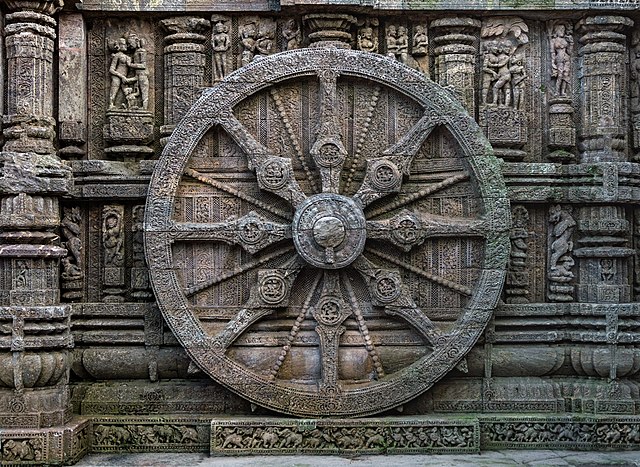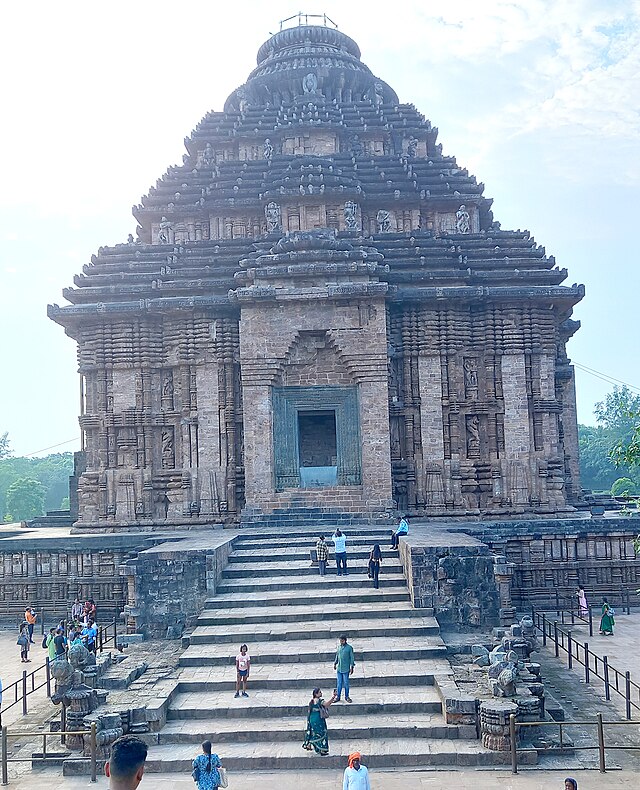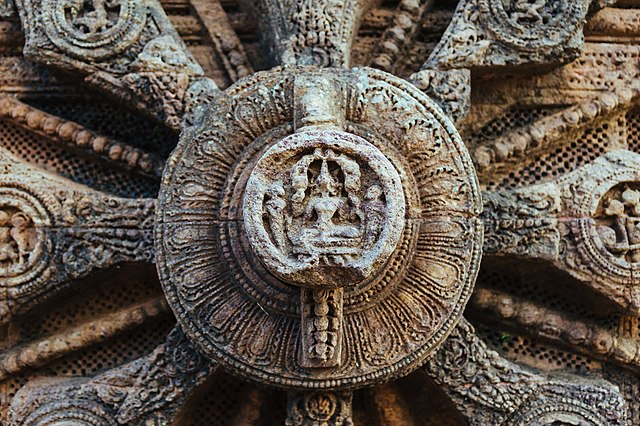Have you ever wondered what it would look like if gods themselves designed a temple? The Konark Sun Temple in Odisha, India, might just be the answer to that question. This 13th-century architectural marvel stands as one of the most breathtaking examples of ancient Indian craftsmanship, designed to resemble a massive stone chariot dedicated to Surya, the Sun God.
Nestled along the Bay of Bengal coast, this UNESCO World Heritage Site isn’t just a temple – it’s a testament to human ingenuity, artistic excellence, and spiritual devotion. Every stone tells a story, every carving whispers ancient secrets, and every wheel seems ready to roll across the heavens.
What is the Konark Sun Temple?
The Konark Sun Temple, locally known as the “Black Pagoda,” is a 13th-century Hindu temple dedicated to the Sun God, Surya. What makes this temple extraordinary isn’t just its religious significance, but its unique architectural design that resembles a colossal chariot with 24 intricately carved wheels, each about 10 feet in diameter, pulled by seven horses.
Located in the coastal town of Konark in Puri district of Odisha, this temple represents the pinnacle of Kalinga architecture. The name “Konark” itself is derived from two Sanskrit words: “Kona” meaning corner and “Arka” meaning sun, literally translating to “Corner of the Sun.”
The temple was conceived as a massive chariot of the Sun God, complete with elaborately carved stone wheels, pillars, and walls. Despite centuries of natural disasters, invasions, and the relentless march of time, the temple continues to mesmerize visitors with its grandeur and artistic sophistication.
Historical Background of Konark Sun Temple
King Narasimhadeva I: The Visionary Builder
The Konark Sun Temple owes its existence to King Narasimhadeva I of the Eastern Ganga Dynasty, who ruled from 1238 to 1264 CE. This visionary ruler wasn’t just a warrior king – he was also a patron of arts and architecture who understood the power of monumental construction in establishing his legacy.
Historical records suggest that King Narasimhadeva I commissioned this temple to commemorate his military victories, particularly against the Muslim invasions. The temple served multiple purposes: it was a place of worship, a symbol of royal power, and a demonstration of the advanced architectural capabilities of his kingdom.
Legend has it that the king employed over 1,200 artisans for 12 years to complete this masterpiece. The construction required not just artistic skill but also advanced engineering knowledge, as the temple was designed to align perfectly with the sun’s movements throughout the year.
The 13th Century Marvel
The 13th century was a remarkable period in Indian temple architecture, and the Konark Sun Temple represents the culmination of centuries of architectural evolution. During this era, the Kalinga style of temple architecture reached its zenith, characterized by soaring spires, intricate carvings, and innovative structural designs.
The temple was built during a time when Hindu kingdoms were asserting their cultural identity against foreign invasions. The grandeur of Konark wasn’t just about religious devotion – it was also a statement of resilience, creativity, and the enduring power of Indian civilization.
What’s fascinating is how the builders incorporated astronomical knowledge into the temple’s design. The entire structure functions as a massive sundial, with the wheels serving as time-keeping devices that can accurately tell time to the minute.
Architectural Brilliance of Konark

The Chariot Design: A Divine Concept
Imagine trying to capture the movement of the sun across the sky in stone – that’s exactly what the architects of Konark achieved. The temple’s design as a chariot isn’t merely decorative; it’s a profound philosophical statement about the nature of time, divinity, and the cosmic order.
The main temple, originally standing about 200 feet tall, was designed to resemble the chariot of Surya as he travels across the heavens. Seven stone horses, representing the seven days of the week, appear to pull this divine vehicle. Each horse is carved with incredible detail, their muscles tensed as if frozen mid-gallop.
The chariot concept extends beyond mere appearance. The entire temple complex was designed to move symbolically with the sun. The main entrance faces east, welcoming the first rays of dawn, while the overall orientation ensures that sunlight illuminates different parts of the temple throughout the day.
Stone Wheels: Engineering Masterpiece
The 24 wheels of the Konark temple aren’t just artistic marvels – they’re functional masterpieces that demonstrate the advanced mathematical and astronomical knowledge of their creators. Each wheel, standing about 10 feet in diameter, is intricately carved with spokes that cast shadows to indicate time with remarkable precision.
These wheels represent the 24 hours of a day, with each wheel corresponding to one hour. The spokes within each wheel further divide time into smaller segments, creating what is essentially a massive stone clock. The precision with which these wheels were carved and positioned shows an understanding of geometry and astronomy that was far ahead of its time.
What’s even more impressive is the artistic detail within each wheel. Every spoke is adorned with carvings depicting various aspects of life – from daily activities to mythological scenes. The rims of the wheels feature intricate floral patterns, geometric designs, and miniature sculptures that would take hours to fully appreciate.
Intricate Carvings and Sculptures
Step closer to any surface of the Konark temple, and you’ll discover a world of incredible detail. The temple walls are covered with thousands of sculptures depicting everything from gods and goddesses to musicians, dancers, animals, and scenes from daily life in 13th-century India.
The sculptors of Konark were masters of their craft, capable of bringing stone to life. Dancing figures appear to move with rhythm and grace, while carved animals seem ready to leap from the walls. The attention to detail is so extraordinary that individual expressions on faces, the drape of clothing, and even intricate jewelry are clearly visible.
Among the most famous carvings are the erotic sculptures, which have sparked countless discussions about their meaning and purpose. These sculptures, far from being merely decorative, represent the tantric philosophy of life celebration and the unity of physical and spiritual existence.
Symbolism in Stone
Every element of the Konark temple carries deep symbolic meaning rooted in Hindu philosophy and cosmology. The temple isn’t just a building – it’s a three-dimensional representation of Hindu concepts about time, space, divinity, and the human condition.
The seven horses pulling the chariot represent the seven colors of white light and the seven days of the week. The 24 wheels symbolize the 24 hours of the day as well as the 24 fortnights in a year. The entire structure represents the passage of time and the eternal journey of the sun across the heavens.
The positioning of various sculptures and carvings also follows strict iconographic principles. Gods and goddesses are placed according to their traditional positions in Hindu cosmology, while the different levels of the temple represent different planes of existence from the earthly to the divine.
Religious Significance and Sun Worship
Surya: The Sun God in Hindu Mythology
Sun worship has been an integral part of Hindu tradition for thousands of years, and Surya occupies a special place in the Hindu pantheon. Unlike many other deities who are abstract concepts, Surya is visible, life-giving, and essential for all existence on Earth.
In Hindu mythology, Surya is depicted as riding a chariot pulled by seven horses across the sky, bringing light and life to the world. He is considered one of the principal deities, embodying knowledge, wisdom, and the power to dispel darkness both literal and metaphorical.
The Konark temple elevates sun worship to an architectural art form. Every morning, as the sun rises over the Bay of Bengal, its rays illuminate the temple, creating a divine spectacle that connects the earthly structure with the celestial deity it honors.
Ritual Practices at Konark
Although the temple is no longer actively used for regular worship due to structural concerns, its spiritual significance remains undiminished. Historically, the temple was a major pilgrimage destination where elaborate rituals were performed to honor Surya.
The daily rituals would begin before dawn, with priests preparing for the sun’s arrival. As the first rays of sunlight entered the sanctum sanctorum, special prayers and offerings were made. The temple’s design ensured that these morning rituals were bathed in natural sunlight, creating a mystical atmosphere that enhanced the spiritual experience.
During the Chandrabhaga Mela, which still takes place annually, thousands of devotees gather near the temple to pay their respects to the Sun God. This festival, held in February, recreates some of the ancient traditions associated with sun worship and demonstrates the continuing relevance of the temple in contemporary spiritual life.
UNESCO World Heritage Status

Recognition and Preservation Efforts
In 1984, UNESCO recognized the Konark Sun Temple as a World Heritage Site, acknowledging its outstanding universal value to humanity. This recognition wasn’t just about the temple’s beauty – it was an acknowledgment of its significance as a masterpiece of human creative genius and its importance in understanding medieval Indian architecture and culture.
The UNESCO designation brought international attention to the temple’s conservation needs. The organization highlighted the temple as representing “a masterpiece of Orissan architecture” and praised its “conception of the temple as a chariot of the Sun God with elaborately carved stone wheels, pillars and walls.”
This international recognition has led to increased funding for conservation efforts and greater awareness about the need to preserve this irreplaceable monument. However, it has also brought challenges, including increased tourism pressure and the need to balance access with preservation.
Visiting Konark Sun Temple Today
Best Time to Visit
Planning your visit to Konark requires some consideration of both weather and lighting conditions. The best time to visit is between October and March when the weather is pleasant and the harsh summer heat of Odisha is absent.
For the most magical experience, plan to arrive at sunrise. Watching the first rays of sunlight illuminate the temple as it was designed to be seen is an unforgettable experience. The interplay of light and shadow across the intricate carvings creates an ever-changing display of artistic beauty.
The annual Konark Dance Festival, usually held in December, offers a unique opportunity to see the temple as a backdrop for classical Indian dance performances. During this festival, the temple comes alive with music and dance, recreating something of its historical atmosphere as a center of cultural activity.
How to Reach Konark
Konark is well-connected to major cities in eastern India, making it accessible for both domestic and international tourists. The nearest airport is Bhubaneswar, about 65 kilometers away, which has regular flights from Delhi, Mumbai, Kolkata, and other major Indian cities.
From Bhubaneswar, you can take a bus, taxi, or train to reach Konark. The journey by road takes about 1.5 to 2 hours and passes through scenic countryside. Puri, the famous pilgrimage city, is just 35 kilometers from Konark and is connected by regular bus services.
For those preferring train travel, the nearest railway station is Puri, from where local transportation is easily available to reach the temple. Many visitors combine their Konark visit with trips to Puri and Bhubaneswar, creating a comprehensive tour of Odisha’s cultural treasures.
Travel Tips for Tourists
Visiting Konark requires some preparation to make the most of your experience. Carry water and wear comfortable walking shoes, as you’ll be doing considerable walking on uneven surfaces. A hat and sunscreen are essential, especially during daytime visits, as much of the temple complex is exposed to direct sunlight.
Photography is allowed in most areas of the temple, but flash photography may be restricted in certain sections to protect the ancient carvings. Consider hiring a local guide who can explain the intricate details and stories behind the various sculptures and architectural elements.
The Archaeological Survey of India maintains a small museum near the temple that houses sculptures and artifacts found during excavation. This museum provides valuable context for understanding the temple’s history and significance.
Mysteries and Legends
The Missing Central Deity
One of the greatest mysteries surrounding the Konark temple is the fate of its central deity. Historical accounts suggest that the main sanctum once housed a magnificent idol of Surya, but this statue disappeared centuries ago under mysterious circumstances.
Some legends claim that the idol was so powerful that it caused ships to crash due to its magnetic properties. Others suggest that it was removed and hidden to protect it from invading armies. Archaeological evidence indicates that the sanctum was indeed designed to house a large statue, but its exact fate remains unknown.
The missing deity adds an air of mystery to the temple and fuels ongoing archaeological interest. Researchers continue to study the temple’s design and historical records, hoping to uncover clues about what happened to this presumably magnificent sculpture.
Archaeological Discoveries
Recent archaeological excavations around the Konark temple have revealed fascinating insights into the temple’s original grandeur and the civilization that created it. Discoveries include fragments of sculptures, coins, pottery, and structural elements that help piece together the temple’s complete original form.
One of the most significant discoveries has been evidence of the temple’s original height and design. Archaeological evidence suggests that the main tower was indeed about 200 feet tall, making it one of the tallest temples of its time. The discovery of foundation stones and architectural fragments has helped researchers understand the engineering techniques used in its construction.
These ongoing discoveries continue to reveal new aspects of the temple’s significance and help conservation efforts by providing crucial information about original construction techniques and materials.
Cultural Impact and Legacy
The Konark Sun Temple’s influence extends far beyond its immediate location, inspiring artists, architects, and scholars around the world. Its unique design has influenced modern architectural projects, while its artistic elements continue to inspire contemporary Indian art and sculpture.
The temple appears on Indian currency and is featured in countless books, documentaries, and academic studies about Indian architecture and culture. It serves as a symbol of India’s rich cultural heritage and architectural capabilities, demonstrating that medieval Indian civilization was capable of creating works that rival any global monument.
For the people of Odisha, Konark represents cultural pride and identity. The temple’s image appears in state symbols, tourism materials, and cultural events, serving as a powerful representation of Odishan heritage and artistic achievement.
Conservation Challenges
Preserving the Konark Sun Temple presents unique challenges that conservation experts continue to grapple with. The temple’s coastal location exposes it to salt-laden winds and high humidity, which accelerate the deterioration of the stone carvings. Additionally, the temple’s age and the soft chlorite stone used in many carvings make it particularly vulnerable to weathering.
The Archaeological Survey of India works continuously to address these challenges through various conservation techniques, including chemical treatments to strengthen the stone, drainage improvements to manage water damage, and protective measures to shield delicate carvings from environmental exposure.
Climate change poses new threats to the temple’s preservation, with changing weather patterns potentially accelerating deterioration. Conservation efforts must constantly adapt to address these evolving challenges while maintaining the temple’s authentic appearance and structural integrity.
Conclusion
The Konark Sun Temple stands as more than just an ancient monument – it’s a testament to human creativity, spiritual devotion, and architectural genius that continues to inspire wonder centuries after its creation. This magnificent stone chariot represents the pinnacle of medieval Indian architecture and serves as a bridge between the earthly and the divine.
From its ingenious design as a functional sundial to its breathtaking artistic details, every aspect of Konark demonstrates the sophisticated knowledge and skills of its creators. The temple reminds us that true art is timeless, capable of moving and inspiring people across cultures and centuries.
Whether you’re drawn by its historical significance, architectural brilliance, or spiritual atmosphere, the Konark Sun Temple offers an experience that transforms visitors and creates lasting memories. As we work to preserve this treasure for future generations, we ensure that the stone chariot of the Sun God will continue its eternal journey through time, carrying with it the dreams and devotion of those who created this masterpiece.
Frequently Asked Questions (FAQs)
1. Why is the Konark Sun Temple called the “Black Pagoda”?
The temple earned the nickname “Black Pagoda” due to its dark-colored stone construction and its distinctive tower that served as a navigation landmark for sailors in the Bay of Bengal. The dark stone appears almost black from a distance, contrasting with the “White Pagoda” of Puri’s Jagannath Temple.
2. Can visitors still worship inside the Konark Sun Temple?
While the main sanctum is sealed for safety reasons due to structural concerns, visitors can explore most of the temple complex and appreciate its architectural beauty. Worship and prayers can be offered in the outer areas, and the temple remains spiritually significant for devotees.
3. How long does it take to fully explore the Konark Sun Temple?
A thorough visit to the Konark Sun Temple typically takes 2-3 hours, allowing time to appreciate the intricate carvings, understand the architectural details, and visit the nearby museum. Photography enthusiasts and history buffs might want to allocate additional time for a more detailed exploration.
4. What makes the wheels of Konark temple special?
The 24 stone wheels of the temple are functional sundials that can accurately tell time. Each wheel represents one hour of the day, with spokes designed to cast shadows that indicate minutes. The wheels also feature intricate carvings depicting various aspects of life and Hindu mythology.
5. Is there an entry fee to visit the Konark Sun Temple?
Yes, there is a nominal entry fee charged by the Archaeological Survey of India for visiting the temple. Indian citizens pay a reduced fee compared to foreign tourists. The fee helps fund ongoing conservation and maintenance efforts for this UNESCO World Heritage Site.

